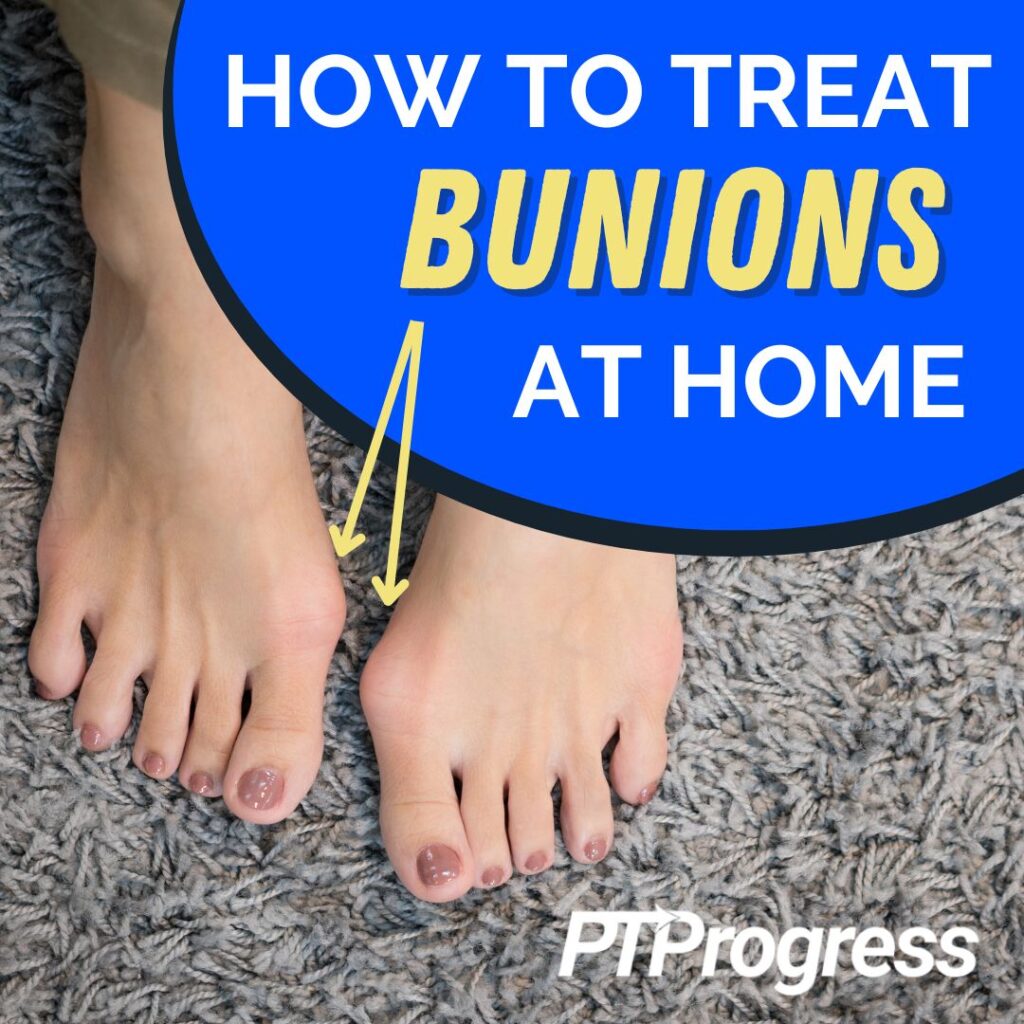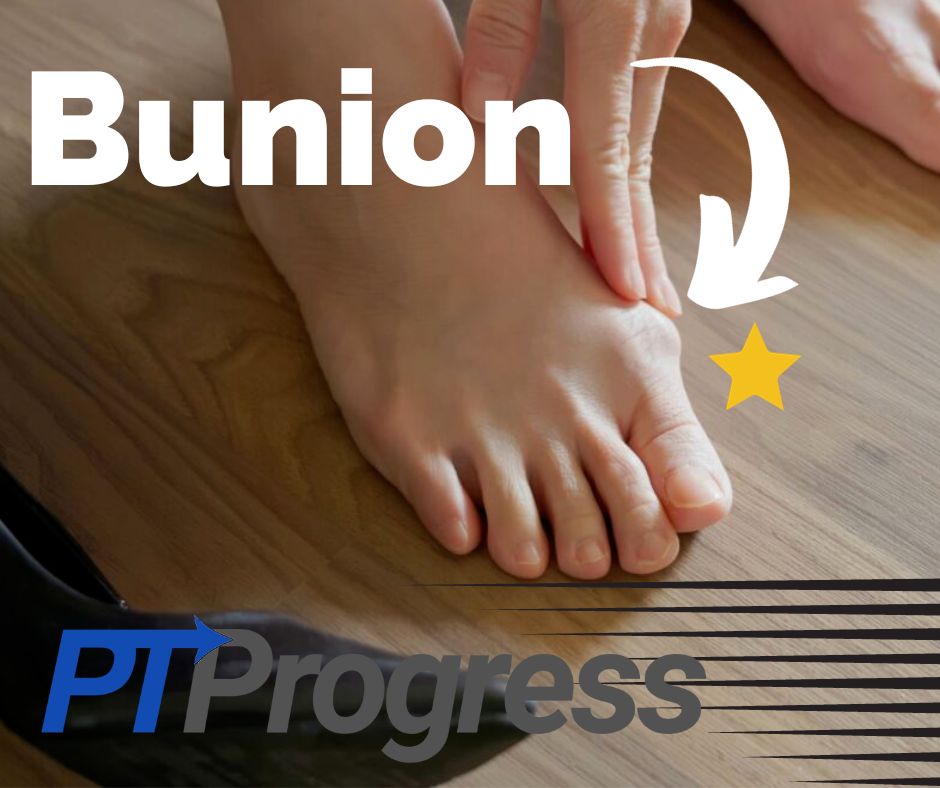
A bunion is a painful bump at the base of the big toe. Consisting of bone and soft tissue, this bulbous bump develops when the toe’s knuckle starts rotating inward in a condition called hallux valgus.
In this article, I unpack everything you should know about treating a case of hallux valgus and any bunions that come with it. There are plenty of remedies to try, whether your toes are just beginning to drift inward or your foot pain is bad to the bunion.
Hallux Valgus: The Drift Behind the Bump
It ends in an unsightly bump, but hallux valgus begins within the inner tendons of the foot. When these tendons become too loose—either from age, trauma, or a medical condition—the big toe destabilizes and rotates toward the foot. The “knuckle” joint or MTP joint overcompensates, spreading outward to keep you balanced. Meanwhile, as it rubs in your shoes with every step, that protruding bone becomes inflamed and develops a soft-tissue bump to protect the joint.
As the bunion progresses, other toes can become affected. In severe cases, the big toe can cross the inner toes or cause them to curl. Whether advanced or not, bunions can become painful and make it difficult to walk and wear shoes.
Causes of Hallux Valgus
Hallux valgus is extremely common, affecting as many as 35% of women over age 65. And even if you don’t currently suffer from a bunion, your likelihood of developing one only increases with age. Let’s explore some of the reasons why so many people experience hallux valgus.
Genetics and Foot Type
The first precondition for hallux valgus is laxity or loose tendons in the feet. And this quality is a hereditary trait. If your older relatives have bunions, chances are you’re predisposed to developing them yourself because of similar laxity in your foot tendons. And if you’re flat-footed, you’ll be more likely to develop a bunion than if your feet have normal or high arches.
Age and Medical Conditions
As the body ages, the tendons in the feet also slacken, which can cause the toe to drift inward in hallux valgus. Other factors commonly associated with age, such as arthritis, can make matters worse, accelerating the development of inflammation and bunions in the feet. A neuromuscular disease such as polio, Charcot-Marie-Tooth (CMT) or hereditary sensory and motor neuropathy (HSMN) can also set the stage for bunions through gradual muscle weakness and bone deformity.
Footwear and Lifestyle Choices

While you may have little control over your medical conditions and none over your age or genetics, your lifestyle choices can make a big impact on the progression and severity of bunion development. Standing for prolonged periods of time in footwear that is too tight across the toes, too narrow in the toe box, or too high of a heel can cause undue stress to the foot, leading to inflammation and that all-too-familiar bump at the base of the big toe.
It’s unclear whether ill-fitting footwear alone can cause hallux valgus, since the condition appears even in populations where shoes are not worn. But wearing poor footwear undoubtedly worsens the condition and can make it much less tolerable.
Gender
Finally, because tight, narrow shoes seem to play such a key role in the acceleration of bunion development, women—and those in “stylish” shoes—are more likely than men to develop bunions. In fact, 90% of bunion cases are present in women instead of men.
How to Fix a Bunion
The ugly truth is that you cannot “fix” or reverse a bunion without surgery.
Surgery involves shaving down the bump, inserting plates to stabilize the loose joint, and returning the toes to normal alignment.
However, you may not need surgery if the bunion isn’t causing you pain or if non-invasive treatment makes the condition tolerable. So although you may not be able to fix your bunion at home (unless you happen to be a foot surgeon, in which case you wouldn’t be reading my article), you absolutely can treat your bunion at home.
Treating a Bunion at Home: 9 Ways
When treating a bad case of bunions, take a two-pronged approach. Your first defense should be to prevent the condition from worsening by straightening the toes and removing any irritants that are causing your bunion pain to flare.
With these measures in place, you can more effectively focus on addressing your symptoms by decreasing swelling and pain.
1. Kick Off Your Shoes—and Put On Good Ones
If you think beauty is pain, tell that to your bunions. Fashionable footwear isn’t worth the aggravation it may be causing your feet. Steer clear of pointy-toed shoes or shoes with a narrow toe box, and don wide-set shoes that allow your little piggies some wiggle room.
In addition, make sure your shoes are supportive and soft-soled. And don’t buy shoes before trying them on. You’ll want to make sure the shoes actually fit your feet, and not the size you think your feet should be.
Keep in mind that one foot may be bigger than the other, and your feet may swell up during the day, so measure your larger foot at the end of the day to get a good sense of your optimal shoe size.
2. Separate Your Toes
Toe spacers or toe separators can help reduce pressure on your big toe by straightening and cushioning your toes. You’d wear these in your shoes or while at home.
There’s a wide range of toe spacing devices available on the market, from foam pads and cushions to silicone molds and fabric wraps. Many devices claim to correct bunions, but the evidence better supports the notion that they can help prevent further irritation and reduce pain as you wear them.
3. Try Using A Splint

Similar to a toe spacer, a bunion splint can help decompress your big toe and correct the hallux valgus drift that’s causing so much pain and discomfort in your feet. Because it wraps around your foot as well as your toe, a splint is usually too bulky to be worn in shoes and is best suited for overnight use.
Although a splint can help straighten your toes while you’re wearing it, it cannot permanently correct your toes or fix your bunion.
4. Wear Custom-Molded Orthotics
A custom orthotic requires a visit with your doctor; it’s not something you can pick up from the drugstore along with your toe spacers and splints. These shoe inserts are molded to the shape of your foot to account for every bump and bend in your musculature, ensuring your foot bears your weight evenly with every step.
Custom orthotics can be pricey, but if walking has become painful from your bunions, they can make a huge difference on your quality of life. Plus, you may notice a slowing in the progression of your hallux valgus after regularly wearing custom orthotics (inside wide-set, soft-soled, low-heeled shoes).
5. Take Painkillers
A bad bunion can make life very painful, especially if you’re on your feet most of the day. A non-steroidal anti-inflammatory drug (NSAID) such as ibuprofen or naproxen can help reduce inflammation in your feet and curb swelling.
6. Ice Your Bunion
An irritated and inflamed bunion can be put at ease with some ice therapy. Grab an ice pack or a bag of ice wrapped in a thin towel (an important step for preventing frostbite!) and apply it to your bunion for 5–10 minutes at a time. The cold temperature will constrict nearby blood vessels and decrease swelling while blocking pain receptors, giving you some non-pharmacological relief.
7. Draw a Foot Bath
Another way to pamper your feet is to soak them in an epsom salt bath whenever they’re feeling stiff and achy. Fill a basin of very warm water with 2–3 tablespoons of epsom salt, and soak your bare feet for up to 20 minutes at a time.
8. Massage Your Feet
Massaging your feet can help ease stiffness, improve circulation, and ward off pain. While seated, begin with one foot crossed on your knee. The area you’ll want to massage is between your big toe and second toe at the base, where the toes join the foot. Using your thumb and forefinger, apply pressure to this area on the foot as long as it’s tolerable. With your free hand you can bend, straighten, and pull at the big toe to help release tension.
Try this technique for 5–10 minutes, until you feel the muscles have relaxed and your toe has a greater range of motion. Repeat on the other foot if desired.
9. Stretch Your Toes
By keeping our feet in shoes all day, we rarely have a chance to stretch our toes. Set aside a couple minutes throughout the day to remove your shoes and socks and stretch your toes to help offset foot pain and reintroduce a range of motion.
You can give your toes a stretch by simply pointing them straight ahead for 5 seconds and then curling them under for 5 seconds. Repeat, alternating straight and curled, 10 times for one set. Aim for 3 sets each day while your bunion pain persists.
Treating a Bunion at Home: Summary
Like so many common maladies, with hallux valgus every ounce of prevention will be worth a pound of cure—especially considering the “cure” (surgery) is painful, invasive, and unsuccessful in 15% of cases.
Bunions are much harder to treat once they’ve progressed, but if you follow these tips, you can slow the progression of hallux valgus and greatly lessen any pain.

